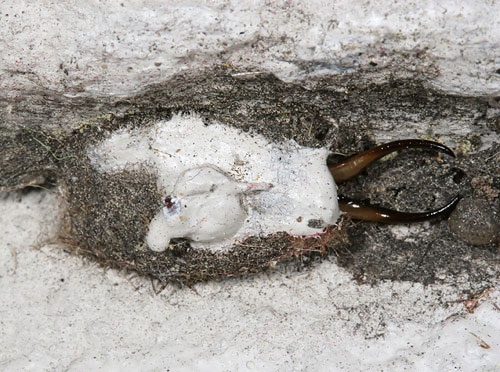Some interesting findings: Carabid beetles & earwigs.
To wet your appetite, the project found very interesting results on who is eating the dreaded codling moth.
In an earlier article we discussed the Carabid beetle as an important but unknown and unrecognised predator. This beetle has been found to be only second to earwigs as a major predator of codling moth.
We know the importance of earwigs—especially in apple orchards—for their appetite for woolly apple aphid. This project has highlighted it as a key predator for codling moth control.
Feeding time
So when do these predators ingest codling moth?
Codling moth larvae, once fully grown inside apples or pears, leave the fruit during summer and autumn and seek cocooning sites.
The codling moths either emerge as second-generation adults over the summer, or overwinter as mature larvae until the following spring.
The cocooned larvae can be found in bark crevices on trees, or in leaf litter and other organic matter on the orchard floor.
Generalist predators active in the tree canopy, the trunk, or on the ground may discover and feed on codling moth larvae in these places.
The project team believe that predation on these codling moth larvae, either moving to or in cocooning sites, can help reduce population levels the following season. However, real numbers were needed to support this belief.
But what was the best way to determine which of the predators found in orchards are eating codling moth larvae in the field?
Many of these lower canopy and ground-dwelling predators are cryptic in their feeding behaviours. Most predators are only actively hunting for prey during the night, and they like to hide in cracks, crevices, ground cover, leaf litter, or soil.
Unlike parasitism, it is difficult to find evidence of predation since usually the whole body of the prey (codling moth) is consumed.
Analysing gut content
Using new molecular technologies has allowed the project team to analyse the gut content of predators, which gave a better picture of what is eating codling moth.
The tricky part was capturing the predators in the orchard and collecting them before they had a chance to fully digest their prey, so there was still DNA material available to analyse.
In over 2400 samples collected from seven orchards during a three-year period, the project team found that about 9% had codling moth DNA in their guts.
The majority of the samples showing codling moth predation came from three main groups: carabid ground beetles (Carabidae), the European earwig, and spiders (Araneae).
The team also found that predation rates varied between the different orchards sampled and were linked to management intensity.
Pooling across all seven orchards, we found 8.5% of the ground beetles, 8% of the spiders, and 16% of the earwigs had fed on codling moth.
Results
These results revealed which predators are likely to be important as biological controls for codling moth, and challenge us to create pest management programs focused on conserving them while continuing to adequately control codling moth and other important pests.
We should also remember that these predators are generalists and feed on many prey types, including each other.
Feeding on codling moth is just one indicator of their importance, as they are also likely preying on other pests such as LBAM and woolly apple aphids.
Predators, such as ground beetles, may also be particularly important in the newer high-density orchards where codling moth is more likely to overwinter on the ground, since trees in these orchards tend to have smooth bark and thus provide fewer cracks and crevices for the larvae to cocoon.
It is clear that biological control alone will not control codling moth to acceptable levels, but these predators can contribute to reducing codling moth population levels. In turn, lower pest pressure will allow mating disruption, softer materials, and possibly fewer cover sprays, to provide more effective controls.
Understanding the ecological role of these predator groups will help shape future orchard management programs while enhancing biological control.
For more information, see Tree Fruit July 2013




















